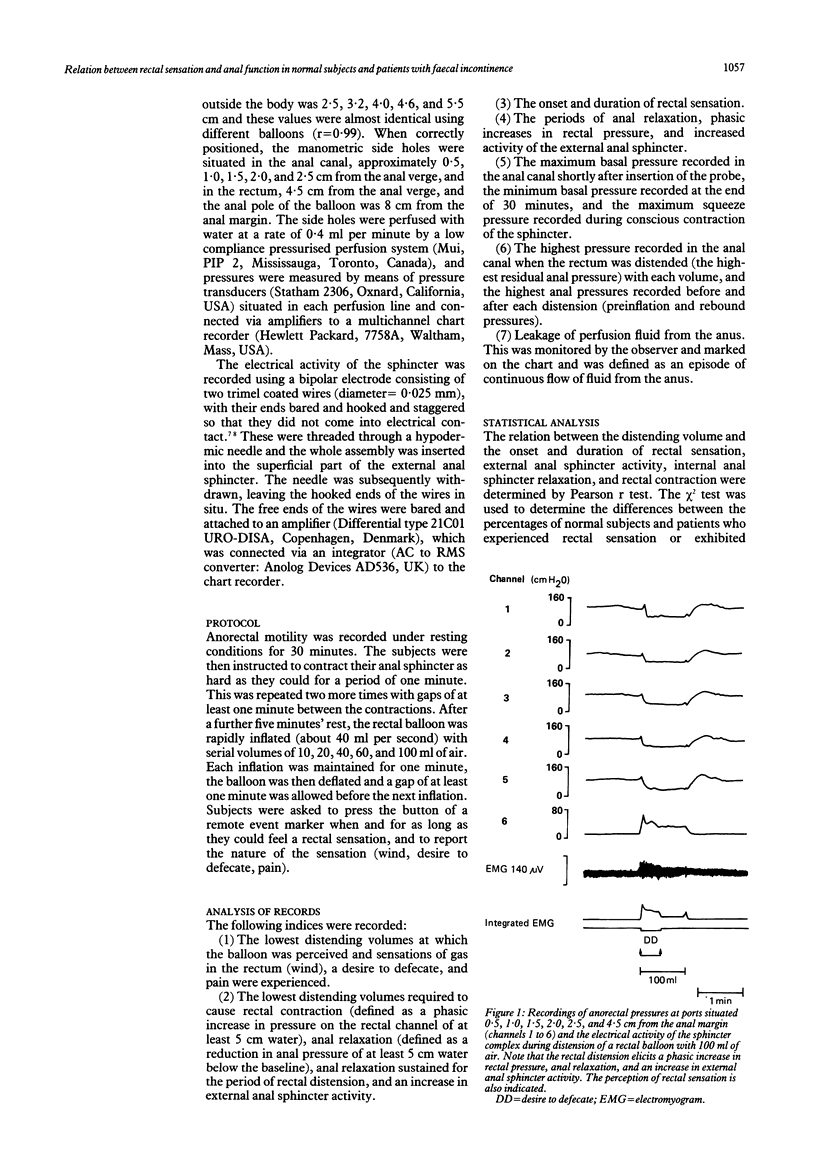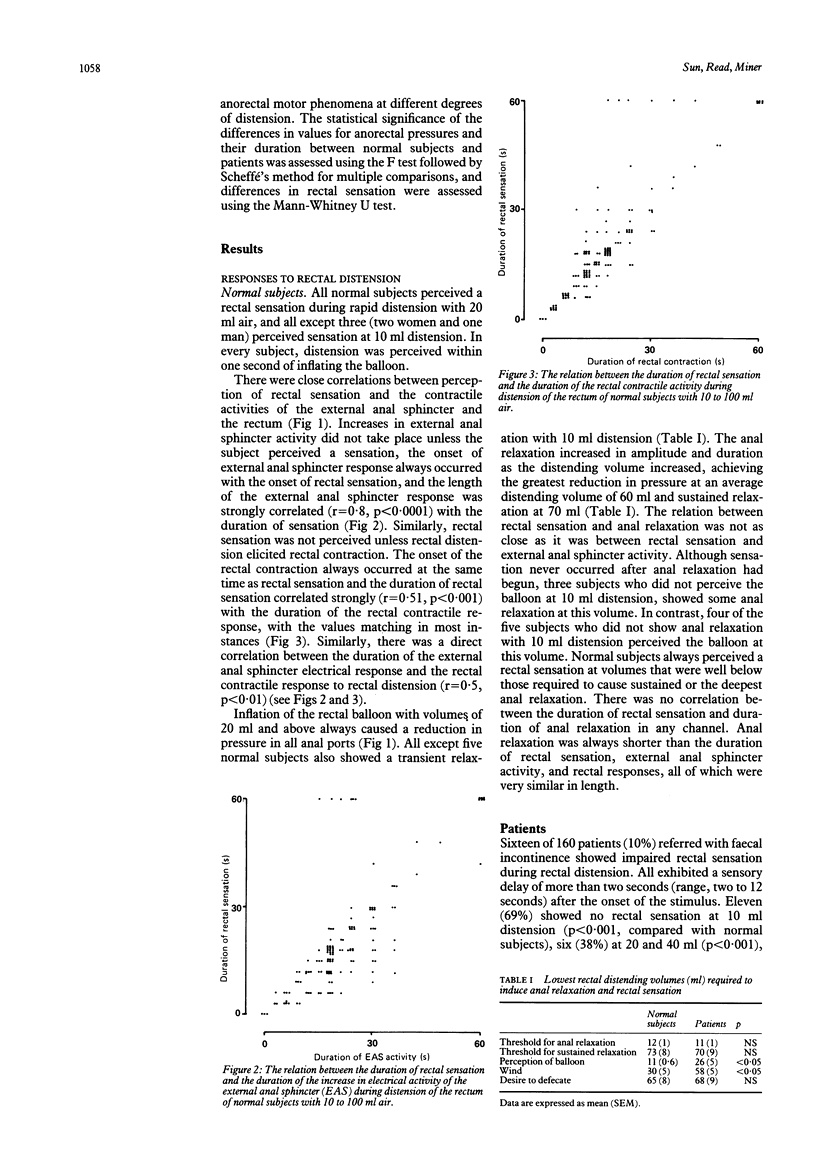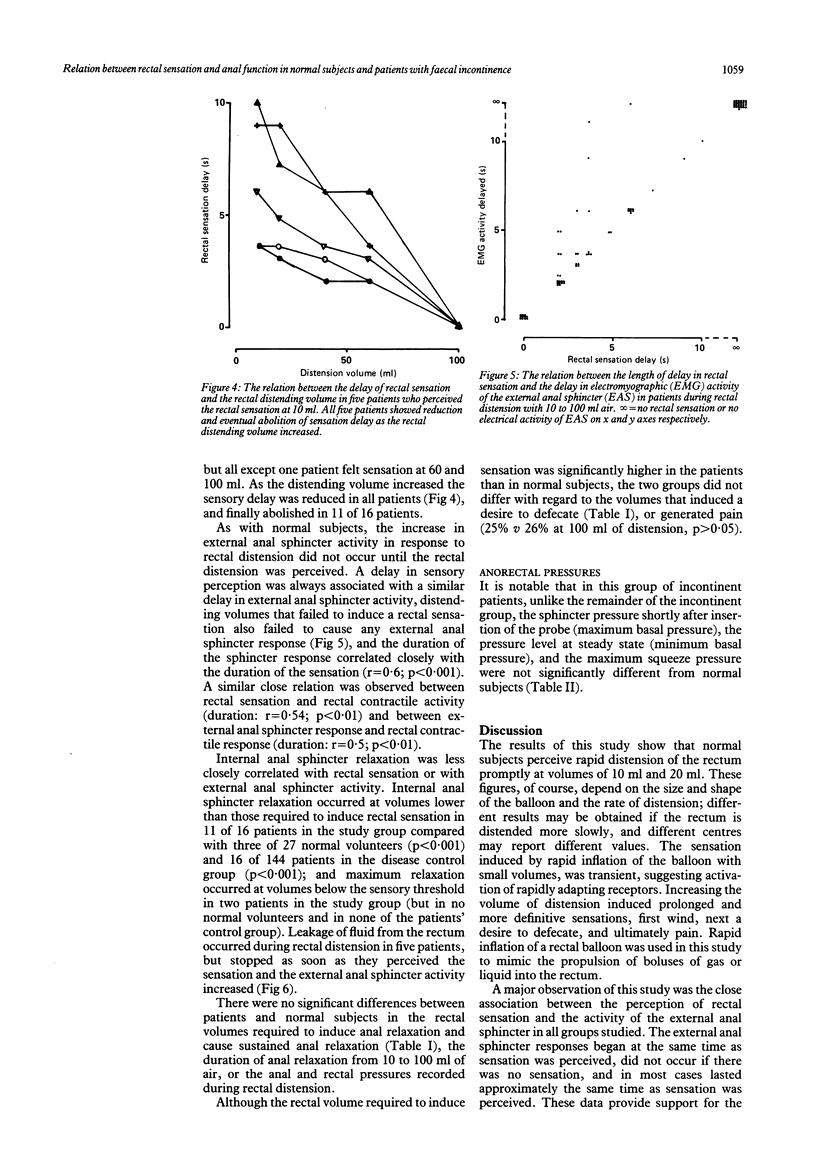Abstract
The relation between sensory perception of rapid balloon distension of the rectum and the motor responses of the rectum and external and internal anal sphincters in 27 normal subjects and 16 patients with faecal incontinence who had impaired rectal sensation but normal sphincter pressures was studied. In both patients and normal subjects, the onset and duration of rectal sensation correlated closely with the external anal sphincter electrical activity (r = 0.8, p less than 0.0001) and with rectal contraction (r = 0.51, p less than 0.001), but not with internal sphincter relaxation. All normal subjects perceived a rectal sensation within one second of rapid inflation of a rectal balloon with volumes of 20 ml or less air. Six patients did not perceive any rectal sensation until 60 ml had been introduced, while in the remaining nine patients the sensation was delayed by at least two seconds. Internal sphincter relaxation occurred before the sensation was perceived in three of 27 normal subjects and 11 of 16 patients (p less than 0.001), and could be associated with anal leakage, which stopped as soon as sensation was perceived. The lowest rectal volumes required to induce anal relaxation, to cause sustained relaxation, or to elicit sensations of a desire to defecate or pain were similar in patients and normal subjects. In conclusion, these results show the close association between rectal sensation and external anal sphincter contraction, and show that faecal incontinence may occur as a result of delayed or absent external anal sphincter contraction when the internal anal sphincter is relaxed.
Full text
PDF





Selected References
These references are in PubMed. This may not be the complete list of references from this article.
- Frenckner B. Function of the anal sphincters in spinal man. Gut. 1975 Aug;16(8):638–644. doi: 10.1136/gut.16.8.638. [DOI] [PMC free article] [PubMed] [Google Scholar]
- Haynes W. G., Read N. W. Ano-rectal activity in man during rectal infusion of saline: a dynamic assessment of the anal continence mechanism. J Physiol. 1982 Sep;330:45–56. doi: 10.1113/jphysiol.1982.sp014327. [DOI] [PMC free article] [PubMed] [Google Scholar]
- IGGO A. Tension receptors in the stomach and the urinary bladder. J Physiol. 1955 Jun 28;128(3):593–607. doi: 10.1113/jphysiol.1955.sp005327. [DOI] [PMC free article] [PubMed] [Google Scholar]
- MELZAK J., PORTER N. H. STUDIES OF THE REFLEX ACTIVITY OF THE EXTERNAL SPHINCTER ANI IN SPINAL MAN. Paraplegia. 1964 Mar;1:277–296. doi: 10.1038/sc.1963.25. [DOI] [PubMed] [Google Scholar]
- Read N. W., Abouzekry L. Why do patients with faecal impaction have faecal incontinence. Gut. 1986 Mar;27(3):283–287. doi: 10.1136/gut.27.3.283. [DOI] [PMC free article] [PubMed] [Google Scholar]
- Read N. W., Bartolo D. C., Read M. G. Differences in anal function in patients with incontinence to solids and in patients with incontinence to liquids. Br J Surg. 1984 Jan;71(1):39–42. doi: 10.1002/bjs.1800710112. [DOI] [PubMed] [Google Scholar]
- SCHUSTER M. M., HENDRIX T. R., MENDELOFF A. I. The internal anal sphincter response: manometric studies on its normal physiology, neural pathways, and alteration in bowel disorders. J Clin Invest. 1963 Feb;42:196–207. doi: 10.1172/JCI104706. [DOI] [PMC free article] [PubMed] [Google Scholar]
- Schuster M. M. The riddle of the sphincters. Gastroenterology. 1975 Jul;69(1):249–262. [PubMed] [Google Scholar]
- Wald A., Tunuguntla A. K. Anorectal sensorimotor dysfunction in fecal incontinence and diabetes mellitus. Modification with biofeedback therapy. N Engl J Med. 1984 May 17;310(20):1282–1287. doi: 10.1056/NEJM198405173102003. [DOI] [PubMed] [Google Scholar]
- Wald A. Use of biofeedback in treatment of fecal incontinence in patients with meningomyelocele. Pediatrics. 1981 Jul;68(1):45–49. [PubMed] [Google Scholar]
- Whitehead W. E., Orr W. C., Engel B. T., Schuster M. M. External anal sphincter response to rectal distention: learned response or reflex. Psychophysiology. 1982 Jan;19(1):57–62. doi: 10.1111/j.1469-8986.1982.tb02599.x. [DOI] [PubMed] [Google Scholar]


